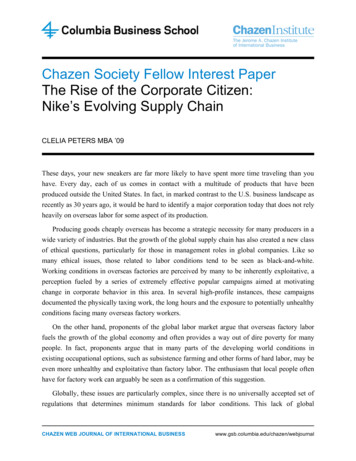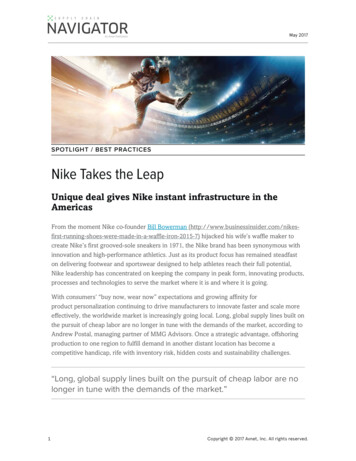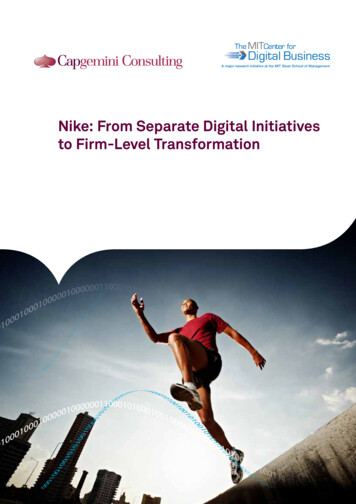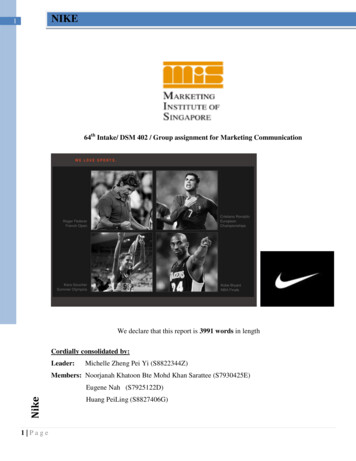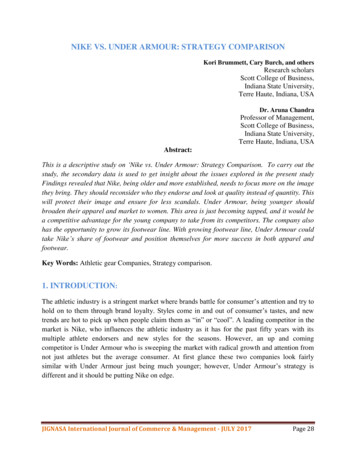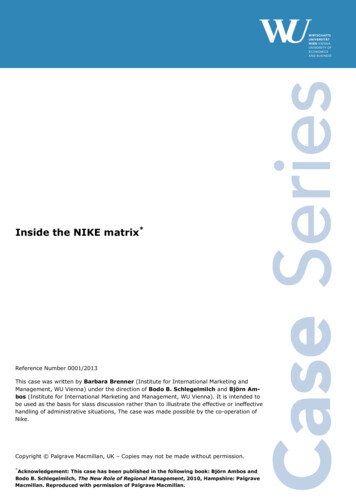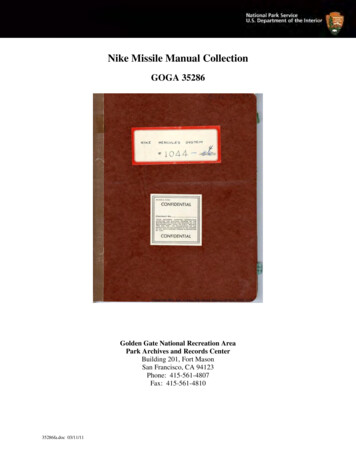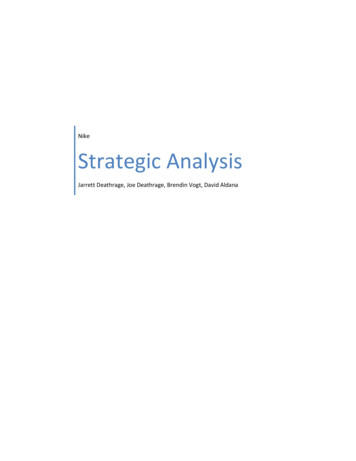
Transcription
NikeStrategic AnalysisJarrett Deathrage, Joe Deathrage, Brendin Vogt, David Aldana
Nike 2Strategic AnalysisTable of contentsI. Who We Are .Pg3.II. Current Strategies .Pg10.III. Problem Identification/Statement .Pg12.IV. Internal .Pg12.V. External .Pg27.VI. Solutions Pg39.Work Cited .Pg44.
Nike 3Strategic AnalysisI. Who We AreFor the past fifty years Nike corporate has been located when it all started,Beaverton, Oregon, which is a suburb outside of Portland, Oregon. The idea of anathletic shoe was taken by Bill Bowerman whom was a respected track and fieldcoach at the University of Oregon in the nineteen fifties. The founder and CEO ofNike corporation is Phil Knight, a track athlete who ran for Mr. Bowerman in thein the middle 1950’s. After graduating from The University of Oregon, PhilKnight earned his MBA at the prestigious Stanford University in California.While studying at the university, Knight had written a report prosing qualityrunning shoes in which he had sent it to numerous shoe factories in countries likeJapan and Asia that would make these shoes compete with the manufactures inEurope. After hearing no response back, Phil decided to take a chance.
Nike 4Strategic AnalysisAfter have making a call to Kobe, Japan, Knight soon became adistributor of Tiger running Shoes in America. After receiving his first shipmentof shoes, Phil Knight had sent them to Bowerman, hoping he would purchasethem for his track team. Instead, Bowerman shocked Knight by presenting tobecome his colleague, and to supply his footwear design ideas to Tiger. Aftershaking hand and investing five hundred dollars each, they had opened up BlueRibbon Sports and had order three hundred more pairs to be shipped to America.While Knight began selling out of his own vehicle, Bowerman would take apartthe shoe and examine ways of how to improve the shoe for better durability andmore lightweight. Alas, the company of Nike had been born. While both had theirown full time Knight decided to bring abroad Jeff Johnson to the Blue RibbonSports team in 1965 and became the first full time employee for the company. Hewas also a runner and had met Knight while also studying at Stanford University.Johnson was a work horse for the company creating the company’s firstbrochures, ads, and marketing schemes as an employee. He also was thephotographer for the company’s first catalogues. He managed the first brick andmortar and established the mail order system as, well. He also designed severalearly Nike shoes, and even came up with the name Nike in 1971. During this timethe relationship with Blue Ribbon Sports and the Japanese manufacture which
Nike 5Strategic Analysisproduced the running shoes was wearing thin. This was when Knight finallystarted to jump from footwear distributor to footwear manufacturer.In 1972 the first line of Nike footwear appeared at the United States trackand field trials in Eugene, Oregon. The famous Nike “swoosh” was created by astudent at Portland State University. Nike had made a very good first impressionwith the runners simply because of the outer sole on its shoe. It had wedgesinstead of it being flat which made for better traction when running.Steve Prefontaine was Nike’s very first athlete to be endorsed. Nikewanted to find an athlete in which the company was founded on. Steve was afellow Oregonian and also ran track for the University of Oregon. He was fromthe small town of Coos Bay, Oregon. Prefontaine was an electrifying athleteduring his time at U of O making it clear that when he raced at Oregon’s HaywardField he was unbeatable. He never had lost a race at his home track over the onemile distance, and quickly gained national publicity in famous magazines such asSports Illustrated for the performance he had in the Munich Olympic Games.Not only was Prefontaine was a great runner but also stretched the mindsof Knight, Bowman, and Johnson in innovation at Nike. After graduating, hequickly became Nike’s ambassador by sending a pair of Nike shoes to prospected
Nike 6Strategic Analysisrunners with a personalized note signed by him. In 1975 his life was cut short atthe young age of 24 however Knight has been quoted that the spirit of Prefontainehas lived on.The 1980s were a focal point in Nikes technology. With the success of theNike Air technology incorporated in the running shoe and with the completion ofthe IPO some of Nike’s major businessmen had decided to step away from thecompany. Phil Knight even decided to take a break in the 83-84 year, although hewas still chairman and CEO.The mid1980s Nike had fallen off the pole position of being the industryleader. After being quiet in the aerobics boom, Nike had found itself in the holeagainst upstart businesses in which the workout category was open. However withthe need of signing an athlete with the new line coming out for the business, Nikequickly found someone reliable in Michael Jordan. As well as in 1987 Niketechnology came out with the Air Max in which created a buzz because of thecommercial that was used that included a song from the Beatles soundtrack called“Revolution”. A year after that it was safe to say that Nike quickly became theking of commercials in the sports industry with its newest commercial tagline“Just do it” that included the great two sport athlete at the time, Bo Jackson. Theline “Just Do It” is still used to this day in our shorts and ads in magazines.
Nike 7Strategic AnalysisBy the end of 1989 the cross training era had begun. With the recentlaunch of the “Bo Knows” commercials this could be credited with the crosstraining boom. Nike had regained control of the market in both the footwear andapparel industry. This was a first for the sports apparel industry to tap into anotherindustry and become the leader and has yet to give the spot up, yet.1990 was a big year for us. We had permanently moved our corporateoffices to Portland, Oregon and had created a store in which won many awards forarchitecture and design called Niketown. The success of this store gave newopportunities to us and grew from one location to many not just in the UnitedStates, but internationally as well. We had designed a few products for golf andsoccer teams; however 1994 was the year we decided to dive in deeper with thosesports. We acquired the whole Brazilian soccer team and as well signed manygolfers. The most notable and controversial golfer at the time in which we signedhad to have been Eldrick “Tiger” Woods for a reported 5 million per year. A lotof people questioned us signing a young golfer for this much money, however itquickly paid off right after he had won the Masters in 1997 for a record of 12shots ahead of the competition.With the new millennium approaching we had created a new footwearcushioning system called Nike Shox. The technology debuted during Sydney in
Nike 8Strategic Analysisthe summer of 2000 at the Olympic Games. The development of Nike Shox tookmore than 15 years of determination and devotion, as our designers stuck withtheir idea until technology could catch up. The result was a cushioning andstability system worthy of joining Nike Air as the industry’s top product to viefor. Just as the millennium and technology was changing, our marketing approachhad to as well. We targeted more people in the world rather than just here, in theUSA with us supporting the world cup with the “big athlete, big, ad, big product”advertisement.i. Mission StatementAsk any anybody. When they think of athletic apparel the first thing thatcomes to mind is Nike. We are the world’s leader in innovator in athletic apparel,footwear and equipment. Our mission states: “To bring inspiration and innovationto every athlete* in the world.” Side note: If you have a body, you are an athlete.Nobody can say that they can never be an athlete. By your actions, you choose ifyou want to be one.ii. Vision StatementWhile that is our mission, our vision indicates “to carry on his legacy ofinnovative thinking, whether to develop products that help athletes of every level
Nike 9Strategic Analysisof ability reach their potential or to create business opportunities that set Nikeapart from the competition and provide value for our shareholders.” The personthat the vision is talking about in the vision statement is Bowerman.iii. CultureAt Nike, we believe that a brilliant, diverse and comprehensive employeebase helps drive the creativity that is essential to our brands. Our employee baseincludes a broad range of functions and roles globally, from retail workers tofootwear designers and from brand and category experts. It doesn’t stop there. Wehave a full logistics team as well as distributors to go along with it and many moreopportunities within the business. The employees we hire not only want to workfor us, but our driven in changing the world with innovations in footwear andathletic apparel technology. In 2005 we wanted to see what our employeesthought about the future of technology and what their jobs will look like in thefuture with our company. We led a process to create shared ownership of a set ofscenarios that all pointed to one conclusion – that the way we did business at thattime would not serve us in a future world.iv. Objectives
Nike 10Strategic AnalysisThe objectives we wish to achieve in the future will include opportunitieson a rise in revenue. With many globally sporting events coming up, it is anopportunity we wish to gain. The Olympics will be a main attraction next year inthe capital of Beijing, China. We can see a rise in profit because of the productswe will produce a collection like the Olympic collection has always beensomething we could rely on consumers buying. As well as the 2008 FIFA WorldCup is also around the corner. With soccer being the world’s most popular sportand ADIDAS being the front runner in anything FIFA it is an opportunity wewish to surpass them in the next few years. It will be in South Africa in four yearswith the home team is actually sponsored by Nike so we are hoping since it is inSouth Africa and they do wear Nike, we would see an increase in sales from thisregion of the globe.II. Current Strategiesi. Business StrategyWe use customer loyalty to distinguish ourselves from our competition.Our consumer knows what they want and are willing to pay whatever they need toget it. We offer high quality goods at an acceptable price. We are perceived as“fancy” to most manufacturers in the industry. We segment our product indifferent ways. Not only do we make apparel but also equipment. We have
Nike 11Strategic Analysisdivided our business into three different demographics: Men, Women, andChildren. Each segment is carefully examined in terms of physical capabilities,sociological needs, and design preference.ii. Corporate LevelWe use strong diversification in what we sale to the differentiation of ourconsumers. The products we sale create value and increase customer satisfaction.Our products include: Apparel, accessories, such as Nike watches or gym bags, aswell as performance equipment, including sport balls, timepieces, eyewear,skates, bats, gloves etc. We produce goods for every major sport as well likerunning, basketball, tennis, golf, soccer, baseball, football, bicycling, volleyball,wrestling, aquatic activities, hiking, fencing etc. We are constantly looking forthat new product or technology that could set apart us from our competitors ineach and every sport.iii. Cooperative LevelIt is important to reach new consumers through our partnerships. In 2006we had team up with Apple creating the Nike app. The result we have is tochange the way people run. In an article put together on Apple’s website SteveJobs was quoted “We’re working with Nike to take music and sport to a new
Nike 12Strategic Analysislevel,” said Steve Jobs, Apple’s CEO. "The result is like having a personal coachor training partner motivating you every step of your workout." ("Apple pressinfo," 2006) Along with our partnership with apple, you can also say that ourendorsements with athletes are a strong focal point in our business. Ever sinceNike was a name we have had an athlete repping our “swoosh” on shoes andapparel. Some big endorsers would have to include Michael Jordan, Tiger Woods,Bo Jackson, Andre Agassi, Ronaldinho, and Lance Armstrong etc. If you canthink of a sport, we can name an athlete that is being endorsed by us.III. Problem/Identification StatementThe problem stated with Nike and what we want to achieve is that whatnew challenges, barriers, trade-offs would be uncovered for global women’sfitness as well as the other businesses as the company abandoned its productdriven mentality in favor of a more consumer oriented approach. We want toreach the consumer personally. Not just the category.IV. Internali. Financials (Ratios)The financial ratios are a measure of the financial condition of a company, toanalyze this situation we rely on the financial statements. Financial ratios are derivedfrom the financial statements and make the analysis of the company possible. Theseratios become more important when we have to compare different companies. There are
Nike 13Strategic Analysissome important categories of financial ratios they measure different abilities that thecompany has.1. Liquidity: The ratios that fall into this category are able to measure howthe company can meet the short-term obligations, and how well thecompany can manage debt. There are two important ratios that we have tolook up in this category and are the current ratio and the quick ratio.Current ratio we can find it dividing the current assets over the currentliabilities. While quick ratio we can find it adding cash plus accountreceivable and then divide the result by current liabilities.2. Assets Turnover: The ratios that fall into this category are able to measurehow efficient does the company uses and allocate their a
Nike Strategic Analysis 9 of ability reach their potential or to create business opportunities that set Nike apart from the competition and provide value for our shareholders.” The person that the vision is talking about in the vision statement is Bowerman. iii. Culture At Nike, we believe that a brilliant, diverse and comprehensive employee


